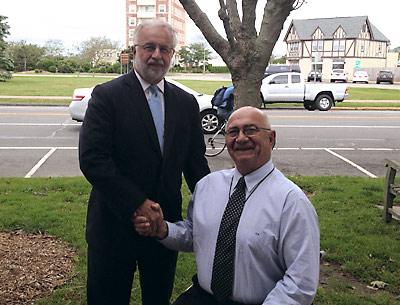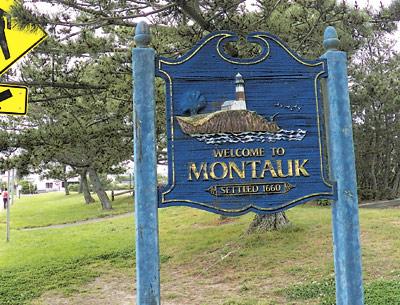Behan Endorses Bishop
Behan Endorses Bishop

In a development demonstrating the influence of national politics on the local scene, Representative Tim Bishop, a Democrat, received the endorsement of John Behan on Monday in La Bodega restaurant in Montauk. Mr. Behan cited the National Republican Congressional Committee’s focus on this district’s campaign as a significant motivation for his decision.
Mr. Bishop, who is from Southampton, is running for re-election for his congressional seat in the first district of New York, comprising most of eastern Suffolk County. His Republican opponent is Randy Altschuler, a businessman and entrepreneur who lives in St. James.
Mr. Behan is a former state assemblyman and former East Hampton Town Republican chairman, as well as a decorated Marine Corps veteran. He has been a prominent figure in both local and regional Republican politics.
In a phone interview on Tuesday, Mr. Behan said that in 2010, when he was the chairman of the town Republican committee, he thought Mr. Altschuler ran a great race. Since then, Mr. Behan has left the committee and has altered his opinion of the candidate, calling him “Houdini” for what he saw as a disappearing act after the last election only to resurface to run for office again. He questioned Mr. Altschuler’s commitment to the district, calling him a “Johnny-come-lately” who moved to the district only to run in it and with no ties to the community.
Mr. Altschuler has challenged those assertions this week and stated in a mass e-mail that his wife’s pediatric practice in Smithtown and his infant daughter’s birth there were evidence of his commitment to this region. His campaign cast Mr. Behan’s endorsement as a local issue, focusing on his involvement with the town’s Republican committee and his falling-out with its leaders since last year’s town election when the town board candidates Mr. Behan proposed — his wife, Marilyn Behan, and Bill Mott — were rejected by them.
In a statement, the Altschuler campaign said the endorsement “was really about local politics, and has no impact on the tremendous momentum Randy has right now.” It cited the endorsements Mr. Altschuler recently received from the New York State Independence Party, the Suffolk County Conservative Party, and the Suffolk County Republican Party. Mr. Bishop had the endorsement of the Independence Party in the 2010 election and more than 7,000 people voted for him on that line. He won the last election by only 593 votes.
Regarding Mr. Altschuler’s campaign. Mr. Behan said his main concern was the involvement of the National Republican ongressional Committee in this district. “Altschuler has a suitcase full of money he is walking around with all of the time. It impresses the [Suffolk County] Republican Committee and the national committee,” which are pleased to have a candidate they do not have to help finance, he said.
George Demos, who was attempting to run a Republican primary challenge to Mr. Altschuler, suddenly dropped out of the race on May 25 citing the need to focus on his wedding preparations. Mr. Behan called this evidence of “shenanigans” on the part of the national committee. “He didn’t just quit one day. They had to make a big offering to Demos for him to drop out. He was as committed to running as Altschuler and Bishop.”
He said the Demos campaign was doing well enough to have been a viable challenge to the Altschuler campaign in a primary. “I’m opposed to the national committee telling us who our candidate should be. It’s unsettling,” Mr. Behan said.
In the last election, Mr. Altschuler initially had the support of the county committee chairman, John Jay LaValle. Mr. LaValle, however, became neutral to negative during the primary race after the state Republican Party chairman’s son decided to run. Christopher Cox, the son of Edward Cox and the grandson of President Richard Nixon, lost the 2010 primary to Mr. Altschuler after he and Mr. Demos split the Conservative and Tea Party votes.
This year, Mr. Behan said he felt that both of the Republican candidates were running to promote their own status and not out of a dedication to public service. Despite Mr. Bishop’s opponents calling into question his campaign’s employment of family members as consultants in previous elections, Mr. Behan said he believed Mr. Bishop was a dedicated public servant.
Mr. Behan represented the South Fork in the State Assembly from 1978 to 1995 and helped create its Veterans Affairs Committee. He was severely wounded in combat in Vietnam and served as director of the New York State Division of Veterans’ Affairs from 1995 to 1998.
In endorsing Mr. Bishop, Mr. Behan praised his commitment to veterans’ issues and his understanding of the concerns of the farmers and fisherman of the East End. “He has a special staff person just on veterans’ issues working with constituents to fight with the Department of Veterans Affairs to get needed benefits. That’s a major position for any elected official to take, to not be ashamed to have a person solely assigned to that task.” He said Mr. Bishop was the first congressman he was aware of from this district to have such a staffer.
Even after 12 years of retirement from the Assembly, Mr. Behan said people still called him for help with governmental problems. “Whenever I need help on a federal level and call Bishop’s office for previous constituents of mine, the doors fly open. Tim Bishop has helped me on several occasions, even though I was the Republican committee chairman. There were no questions about party affiliation.”
Despite the national focus on this district, Mr. Behan said he thought residents would continue their tradition of voting for people they respect and who they believe will help their families the most. “It’s the person, not the politics. I think a lot of people feel the same way I do, even if they aren’t willing to say so publicly.” He noted that when Otis Pike was a Democratic congressman more than three decades ago he served on a Republicans for Pike committee, and Mr. Pike endorsed him for the Assembly.
Mr. Behan said Mr. Bishop is a viable candidate and early polling from the Bishop campaign has shown him with a 17-point lead over Mr. Altshculer. Still, he worried about the Democrat being dragged down by those going to the polls to vote against President Barack Obama. “They’re fed up with Obama and anyone associated with him. I agree it’s time for Obama to go, but not Bishop.”

